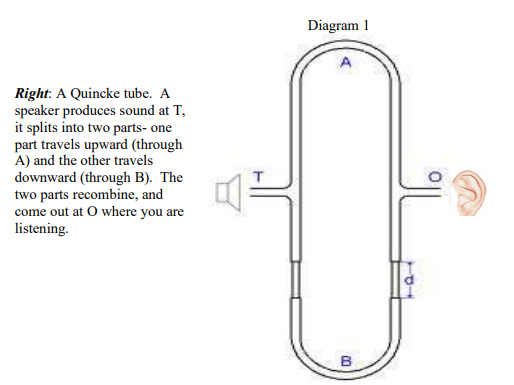Refer to diagram 1. Assume the speed of sound in air is 380 m/s. This question again refers to a Quncke tube (as in question 2). Suppose the length of the longer tube is at the minimum length so there is total destructive interference when the frequency of the note played by the speaker at frequencyf = 20 Hz. Now, the frequency of the sound increases at a steady rate: = 6.06 Hz/s. If the shorter dt tube remains at constant length, at what rate must the longer tube have to change in length, in cm/s, so you continuously have total destructive interference when f = 790 Hz? (The sign will tell if it is increasing or decreasing.)
Refer to diagram 1. Assume the speed of sound in air is 380 m/s. This question again refers to a Quncke tube (as in question 2). Suppose the length of the longer tube is at the minimum length so there is total destructive interference when the frequency of the note played by the speaker at frequencyf = 20 Hz. Now, the frequency of the sound increases at a steady rate: = 6.06 Hz/s. If the shorter dt tube remains at constant length, at what rate must the longer tube have to change in length, in cm/s, so you continuously have total destructive interference when f = 790 Hz? (The sign will tell if it is increasing or decreasing.)
Related questions
Question
Question in attachments

Transcribed Image Text:Diagram 1
A
Right: A Quincke tube. A
speaker produces sound at T,
it splits into two parts- one
part travels upward (through
A) and the other travels
downward (through B). The
two parts recombine, and
come out at O where you are
listening.
B

Transcribed Image Text:Refer to diagram 1.
Assume the speed of sound in air is 380 m/s.
This question again refers to a Quncke tube (as in question 2). Suppose the length of the longer tube is at the minimum length so there is total destructive interference
df
when the frequency of the note played by the speaker at frequency f = 20 Hz. Now, the frequency of the sound increases at a steady rate:
= 6.06 Hz/s. If the shorter
dt
tube remains at constant length, at what rate must the longer tube have to change in length, in cm/s, so you continuously have total destructive interference whenf = 790
Hz? (The sign will tell if it is increasing or decreasing.)
Expert Solution
Step 1
For a destructive interference,
We have a path difference
At minimum length of longer tube n=0
Step by step
Solved in 2 steps
